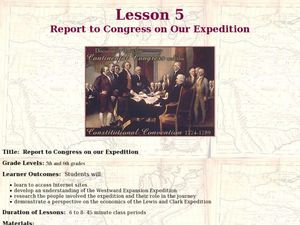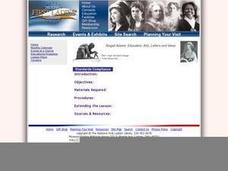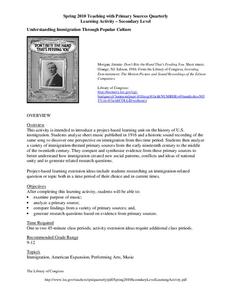Curated OER
Immigration/Migration: Today and During the Great Depression
Eleventh graders compare experiences of their families to those living through the Great Depression using famiy interviews, photographs, films and document from the Library of Congress.
Curated OER
Picturing First Families
Students complete a variety of activities as they study Washington, D.C., the Presidency, and George Washington. They take a virtual trip to Washington, D.C., and visit the National Portrait Gallery, the White House, and the Library of...
Curated OER
Interviews with the American People "Days of Infamy"
Students compare and contrast statements made by people in "Man on the Streets." They are interviewing them on the current war in Iraq and how they felt on Sept. 11th. These interviews are tape recorded. To see what kinds of questions to...
Curated OER
The Home Front (Circa 1863)
Students interpret historical evidence presented in primary and secondary resources. In this American Civil War lesson, students examine sources and then write personal accounts of the war.
Curated OER
Report to Congress on Our Expedition
Students research in small groups to locate information on the outcomes and observations made during the Lewis and Clark expedition. In this westerns expansion lesson, students role play their findings as though they were reporting to...
Curated OER
Computers: Copyright Law
Students visit various Websites to find information about copyright laws. Their research includes information about legal and ethical behaviors regarding Internet use. In addition, students complete online student activity sheets.
Curated OER
Organizers for Students
Students . In this organization instructional activity, students have a general discussion about sports cards and make a chart to answer the questions. Students read the baseball card story from USA Today. Students watch a web video...
Curated OER
Photographs from the Great Depression: Jacob Have I Loved 
Students research the Great Depression and World War II. In this Great Depression lesson, students analyze photographs of the depression era as they begin reading Katherine Paterson's Jacob Have I Loved.
Curated OER
A New Deal for the Arts - WPA Photographs
Students examine school life during the 1930s. They discuss the Great Depression and the New Deal, examine and discuss photographs from the Library of Congress website, and complete a worksheet about school life during the Great Depression.
National First Ladies' Library
Jefferson's Legacy: A National Library
Students examine the creation of the Library of Congress. They investigate reasons why Thomas Jefferson sold his personal collection to the Library. Employing various research resources, students write newspaper articles about the sale...
Curated OER
National Congress of Neighborhood Women
Students research and create a case study as an illustration of the different programs created by the National Congress of Neighborhood Women. Then they present their cases to the class and discuss.
Curated OER
The Three Branches of Government
Sixth graders discover details about the 3 branches of government. In this primary source analysis lesson plan, 6th graders examine documents and images from the Library of Congress to investigate the structure of the U.S. government.
Facing History and Ourselves
The Importance of a Free Press
"Congress shall make no law . . . abridging the freedom of speech, or of the press;. . ." Why is this guarantee of free speech and a free press the First Amendment to the US Constitution? Why are these rights so essential to a democracy?...
Curated OER
In Congress Assembled: Continuity and Change in the Governing of the United States
Students interpret history using primary resources and secondary research. The Constitution is examined and changes are explained within the time period they were made.
Library of Congress
Understanding Immigration Through Popular Culture
Class members are introduced to a project-based learning unit on US immigration with an activity that asks them to analyze sheet music and other primary source materials to uncover issues raised by immigration.
National First Ladies' Library
Rosie the Riveter
Learners identify and interpret the power of symbols. Then they research and identify what type of information that they can locate at the Library of Congress website and list what they learned from it in the time allotted. Students also...
Curated OER
Library of Congress Learning Page: The Historian's Sources Lesson Overview
Young scholars study techniques for analyzing primary sources. Finally, students apply these techniques to analyze documents about slavery in the United States.
Curated OER
Pay to Play?
Lead your class in a discussion about how they believe money influences politics. After reading "Go Ahead, Try to Stop K Street" from the New York Times, they evaluate the claims in the article about the current lobbyist scandal in...
Curated OER
Oil Crisis: What Would You Do?
The dynamics between the economies and politics of the United States and the Middle East are here to study. Upper graders read and discuss scenarios relating to OPEC and the current oil crisis, then in small groups role-play members of...
Curated OER
In Their Own Words: Slave Narratives
Students identify primary sources, explain the strengths and weaknesses of personal accounts in history, and negotiate the Library of Congress Database. They also analyze documents and write a summary that compares and contrasts the...
Curated OER
Westward Expansion: Links to the Past
Young scholars investigate the impact of Manifest Destiny. In this California history lesson, students conduct research on the settlement of the state between 1849 and 1900. Young scholars use their findings to create scripts that link...
Curated OER
War is Hell
Tenth graders identify a veteran of a foreign war. They use the Veterans History Project website, research on-line interviews for information on interview questions. They research war and graphics using the Library of Congress online...
Facing History and Ourselves
The Political Struggle, 1865-1866
Healing versus justice. The central source of tension following the United States Civil War was between the demands for healing and the demands for justice, the battle between President Andrew Johnson and Congress. A video introduces the...
Facing History and Ourselves
Interracial Democracy
Radical Reconstruction, the 10-year period referred to after Congress passed the Reconstruction Act of 1867, saw the establishment of manhood suffrage, men voting without any racial qualifications. Southern states also rewrote their...

























